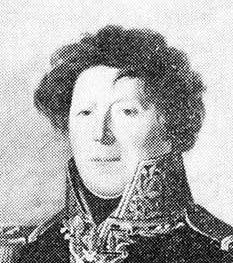General Joseph Chabran

Born: June 21, 1763
Place of Birth: Cavaillon, Vaucluse, France
Died: January 28, 1843
Place of Death: Avignon, France
Arc de Triomphe: CHABRAN on the south pillar
Pronunciation:
The son of farmers, Joseph Chabran worked as a professor of mathematics at the Oratoriens before the Revolution. After the onset of the Revolution, in August of 1792 he was elected capitaine of the 5th Battalion of Volunteers of Bouches-du-Rhône. Sent to the Army of Italy, Chabran was assigned to the staff by General Dumberion. He served at Perus and Lignier and then in February of 1794 he was promoted to chef de bataillon by the representatives of the people. In April of 1794 Chabran took part in the expedition to Oneglia and Saorgio under General Masséna. The next year he was promoted to chef de brigade in June and then he served at the Battle of Loano in November.
For the Italian campaign of 1796, Chabran served initially as part of Masséna's division. That May he served at Lodi and then in August he served at Lonato . On September 4th, Chabran fought at the action of Corona, the combat of Monte-Baldo, and at Roveredo and General Bonaparte promoted him to général de brigade that day. Four days later Chabran fought at the Battle of Bassano . Chabran switched between divisions in the following months and then in March of 1797 he served at the Tagliamento. In April of 1797 Chabran served under Kilmaine against the insurgents of Verona and then in May he took command of the Veronese. That October he obtained a saber of honor and he was ordered to repress the troubles in the lower Alps.
In September of 1798 Chabran took command of the département of Bouches-du-Rhône and then two months later he joined the Army of Switzerland. 1799 was a busy year for Chabran, starting with February when he took part in the crossing of the Rhine. The next month Chabran won at Coire where he had the distinction of taking prisoner the Austrian General Auffenberg. That May he won at Luzisteig and then in June he was promoted to général de division. In August Chabran occupied Rapperswil and then he took command of the 8th Division of the Army of Switzerland. The following month he was ordered to guard the bridge of Bâle and then in October he took command of the 7th Division. He finally finished the year by joining the Army of the Rhine.
In 1800 Chabran began the year by commanding the 1st Division of Reserve formed of depots of the fourteen battalions of the Army of the Orient stationed at Chalon-sur-Saône. In April he took command of the 5th Division of the Army of the Reserve and he served under General Victor. Chabran led his men in crossing the Little Saint Bernard Pass and in May he ordered the siege of Fort Bard which he seized on June 1st. Ten days later he was placed under Duhesme's command and then after the conclusion of the campaign he returned home in September. Chabran was not actively employed for the next two years and then in 1803 he was given command of the isles of Ré, Oléron, Yeu, and Aix. In 1804 he was named a Commander of the Legion of Honor and then in 1805 he took command of the 12th military division. Next he took command of the camp of Saintes and then the 10th military division at Toulouse where he would remain for the next three years.
In 1808 Chabran was sent to Spain, commanding the 1st Division under Duhesme. He repressed an insurrection at Tarragona in June and then defeated insurgents at Arbos. Next Chabran served in General Gouvion Saint-Cyr's V Corps and he served at the Battle of Molins del Rey in December. He went on to become governor of Barcelona, but not for long. In May of 1810 he was denounced by the police for allegedly giving freedom to a criminal in exchange for money. Regardless of the veracity of the allegations, Chabran went on leave for reasons of health and retired. In 1814 during the Bourbon Restoration he was named a Knight of Saint Louis and a Count.
Bibliography
- Divry, Arnauld. Les Noms Gravés sur l'Arc de Triomphe. Paris: L'Harmattan, 2017.
- Six, Georges. Dictionnaire Biographique des Généraux & Amiraux Français de la Révolution et de l'Empire (1792-1814). 2 vols. Paris: Gaston Saffroy, 2003.
Updated August 2017
© Nathan D. Jensen